Inter Simone Inzaghi: How To Score Without Dribbling
An in-depth analysis of Inter with Simone Inzaghi's rotations, positional interchanges, space and time exploitation to create goal-scoring opportunities.
In an era of coaches tweaking their philosophies and styles to provide quality moments in wide channels for the wingers to be in one-versus-one situations and stretch the width of the pitch, Inter and Inzaghi are defying the odds. Nerazzurri almost never dribbles to take on opponents. In contrast, their utmost weapon is swift passes to weave past the adversary. Not only that, but they score a lot of goals.
What style of play does Inter execute to create opportunities? What types of movements and rotations do they use to unbolt defensive blocks?
We bring you the need-to-know about Inter Inzaghi’s patterns with the ball from a statistical and tactical lens.
What do statistics say
According to Fbref, data show that Inter with Inzaghi seldom dribbles, as they accumulated the fewest attempted take-ons per game (9.47 attempted take-ons per game) among teams operating in the top five leagues in the 2024/25 season. However, the anomaly lies in the fact that they find a lot the back of the net. In fact, they have the fourth-best rate in terms of goals scored per game. Only Paris Saint-Germain, Barcelona, and Bayern Munich override them in this regard which is logical as all three teams contain the most efficient and clinical dribblers in Europe (Jamal Musiala, Vinícius Júnior, Rodrigo, Ousmane Dembélé, Bradley Barcola, …)

In addition, Barcelona, Bayern Munich, and Paris Saint-Germain play with systems that deploy wingers on the flanks and a number ten operating behind the striker. Thus, it makes sense that there is a correlation between take-ons and goals.
In stark contrast, Inter has been counting on the 3-5-2 formation since the arrival of Simone Inzaghi. This system requires two wingbacks, who are mainly tasked with creating chances for the two strikers from the flanks. Therefore, having players who can deliver neat, accurate crosses is a must to score goals. Also, it seems that Inzaghi is not interested in dribblers, as it is quite apparent in Inter’s player recruitment.

As the graph (above) shows, AC Milan, Napoli, and Fiorentina are topping the league in terms of attempted take-ons. That is due to their playing style, which relies on wingers in the first place. AC Milan has Rafael Leão working in sync with the left-back Theo Hernandez and dancing with the ball to burst past opponents. On the right, Rossoneri has at their disposal Samuel Chukwueze and Cristian Pulisic, who are top-notch cogs in one-versus-one situations.
Nevertheless, Serie A is still the league with the fewest successful take-ons among the top five leagues, accumulating an average of 6.787 per game. As a result, Inter is just a reflection of their nation. Historically, Italy constructed a football reputation based on defensive solidity and compact lines without the ball. Their exceptional players comprise goalkeepers, defenders, proficient midfielders, and playmakers. Dribblers were not their cup of tea.

Nonetheless, what Inter offers in terms of playing style is: ball-carrying.

Fluid rotations and position interchanges that cut through opponents: wide center-backs hugging the touchlines, central midfielders dropping to the backline, central center-back playing as situational holding midfielder, wingbacks advancing and narrowing inside with strikers coming deep to hold up play.
What makes Inter Inzaghi a unique team is their ability to strike from fast breaks or generate artificial transitions through lightning, sonic, and swift passing sequences.
Fluid rotations all over the pitch
In their win by 4-0 over Atalanta, Hakan Çalhanoğlu and Nicolo Barella dropped to the defense as situational central center-back and right center-back, respectively, with Bastoni advancing to midfield. That saw Benjamin Pavard push high up the pitch down the right flank (higher than the wingback Darmian). Atalanta is one of the best teams in Europe in the man-marking press, involving ten outfield players to throttle the opponents. However, Inter exploited Gasperini’s man-oriented approach by the book.
To elaborate, the Atalanta press evolves around ten players following ten cogs from the opposition side. Therefore, Gasperini’s players react based on the opponents’ movement all over the pitch. As a result, Inter’s wide center-back advancing high and midfielders dropping deep forced Atalanta’s men to defend in unusual and awkward positions. Here, the attacking midfielder, Marco Brescianini, finds himself covering a center-back space and tracking Benjamin Pavard. By default, an offensive player cannot be well-versed to fulfill defensive roles he isn’t accustomed to, and vice versa.


In addition, rotating positions are the kryptonite to man-oriented systems, as the team in possession will always determine the next action. Thus, the opposition needs at least parts of a second to process and react, which supplies the other team with the time and space to move the ball.
Here, Zappacosta and Pašalić are distant and late on the jump against Darmian and Mkhitaryan, allowing the duo to combine and access Pavard. From there, Mkhitaryan has enough separation from Pašalić to pick out Marcus Thuram at the edge of the box—Inter’s striker scores from a deflected square pass. Atalanta's man-to-man press left them vulnerable at the backline as De Roon was isolated against Lautaro Martinez attacking the middle of the net and Bellanova defended alone versus Dimarco targeting the back post. So, Marcus Thuram's cross was posing a tremendous threat before Djimsiti slid to deviate the ball from its initial path.
Inter was in a numerical match with Atalanta down the right side. However, Inzaghi men's rotations with quick ball circulation cut through Atalanta’s block, an inevitable outcome when the player is the reference to take into consideration for the opposition team.
In this example, Inter central midfielders Nicolo Barella and Henrikh Mkhitaryan operate in wider positions near the flanks. Alessandro Bastoni pushes to the last line to form a five-versus-five between Atalanta’s line. Inter’s shape takes a form close to 4-1-5. Once Francesco Acerbi releases the pass to Dimarco, he sprints down the left-inside channel as the third man to receive Bastoni’s pass. However, Mario Pašalić cuts the pass off, and Mkhitaryan collects the loose ball, regaining possession. Inter insists on the five corridors being occupied for better circulation of the ball and generation of passing lanes. Inter Inzaghi embodies the concept that the right player must fill the space at the right moment.

Notice the space Acerbi was attacking behind Atalanta’s backline if Alessandro Bastoni's pass was played behind the block.
In the 8th minute of Inter against Atalanta in August, Barella, Çalhanoğlu, and Mkhitaryan formed the back three of Inter during the initial phase, with the center-backs moving high. Mateo Retegui closed access to Mkhitaryan with an arced run. As a reaction, Acerbi traveled vertically, offering Yann Sommer a passing option ahead, taking advantage of Samardžić's lateness to pick out Lautaro Martinez coming deep to switch the ball to the left side. Atalanta couldn’t afford more than a player to prevent Inter from taking the ball forward. Therefore, Mkhitaryan has the space at his disposal to progress.

Here, every Inter player maintains his position except Acerbi, who plays as a situational midfielder. Pavard fills his place in the center of the defense, and Darmian acts as a right center-back. Benjamin Pavard feeds Bastoni on the left and travels up the field down the left-inside channel for the third-man combination, dropping Marcus Thuram to release Dimarco in space.

During the progression process, Mkhitaryan swapped positions with Benjamin Pavard, who benefited from Mateo Retegui giving up tracking him back. This allowed him to combine with Marcus Thuram, who pulled De Roon out of his position, generating space for Dimarco to attack.
Playing over to one of the two forwards who drop between the lines to lay the ball off to one of Inter’s eights and then liberate the wingback in space behind became a marquee pattern Inter uses to riddle opponents. No matter who they face, Inter’s strikers’ ability to hold up play, midfielders’ capability to play from first-time touch, and wingbacks’ skills in sniffing and pouncing on space give them the edge to execute this sequence close to perfection and take the ball up the field.

In this example concerning their draw against Manchester City, Kevin De Bruyne’s run toward Acerbi and closes off only the left options, whereas alternatives are available in a vertical sense. In addition, Nicolo Barella shifting across enlarges the gap between the lines so Marcus Thuram can drop out for the layoff. Barella, taking advantage of Rodri’s distraction with the ball, gains separation and sets Darmian behind Gvardiol.
Here, Acerbi advances into midfield, with Çalhanoğlu operating as a situational central center-back. Nicolo Barella drops in without being pressurized, with Gavrdiol and Grealish waving their hands, showing their resentment as Rodri didn’t follow his man. De Bruyne, Bernardo Silva, Haaland, Grealish, and Rodri swarm to pounce over Barella as a reaction. However, the latter picks out Piotr Zieliński, coming across between the lines. In the meantime, Darmian attacked the space down the right flank behind Gvardiol to receive and switch the play to the left, where Augusto and Thuram doubled up on Manuel Akanji.
In fact, Manchester City’s press helped Inter progress with the ball. The lateral block shift couldn’t be effective and successful if the passing lanes and angles aren’t properly closed off, with every player making sure he marks his man keeping enough proximity to shrink the space around him and prevent him from receiving. In addition, the lateral shift has to guarantee that the ball holder cannot switch the play to the far side options. In this example, Kevin De Bryune is late in shifting toward Yann Bisseck, and Rodri suddenly stops and doesn’t keep following Barella, with Zieliński freely strolling between the lines.

As a result, a domino effect occurs. Barella has time and space to feed Zieliński between the lines, taking five players out of the equation. Then, Rico Lewis is forced to leave his place and jump late onto Zieliński, vacating the left side for Augusto to push up and double up on Akanji with Thuram. Taremi also drops short, pulling Rúben Dias out of his position. Furthermore, Josko Gvardiol abruptly decides to shift toward Dias, allowing Zieliński to pick out Darmian near the flank.
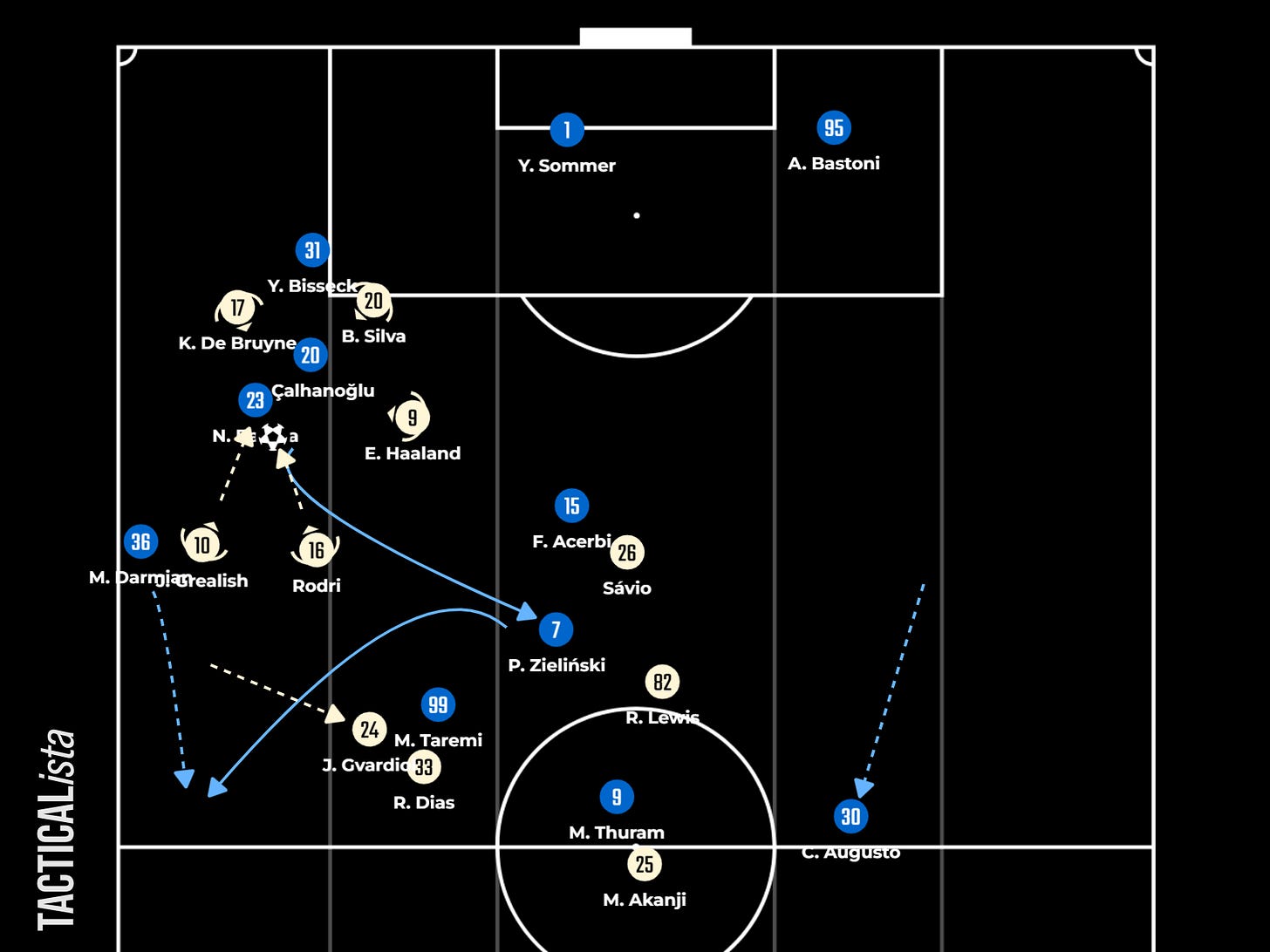
In Inter’s draw versus Napoli, Antonio Conte pressed in a man-to-man fashion. In this example, Inter’s players rotate positions as usual. Napoli’s press leaves them in 1v1 in the backline against one of the best strikers to play with their backs to the goal and could perfectly hold the play up. Therefore, Yann Sommer targeted Lautaro Martinez with a long pass, who headed it toward Dimarco’s feet. Ahead, Marcus Thuram was shifting across to the left, and Dumfries was wide on the right, which stretched the distance between Napoli’s center-back and left-back. That saw Benjamin Pavard coming from behind to exploit the space generated in the center and penetrate the box.
Instructing the midfielders to shift wide proved to be a weapon to progress because of the affordance that comes with such a trick. To elaborate, a central midfielder moving wide lures the opposition midfielder to also dash wide, which opens a gap in the center for one of the players in the last line to drop out. In the other case of a midfielder drifting near the touchlines without being tracked, it offers his teammate a free option to pick out. As a result, it is a loss-loss scenario.

Here, Frattesi operates wide on the right, drawing Merino’s attention. While Merino scans Frattesi’s position, Çalhanoğlu wins separation to proceed. In addition, Partey’s hesitation to jump over Çalhanoğlu or stay with Zieliński puts him in a dilemma and forces Ben White to pounce on, as it freezes his mind and legs and affords Inter free options. The impact is accumulated, resulting in free space behind Ben White. Up, back, and through pattern takes the white and black team up the field.
Strikers deeper movements
The Inter vs. Atalanta game proved to be a model for other teams to bypass Gasperini's aggressive man-to-man press. Rotations breed confusion within the opposition team, and confusion requires time to be processed for reaction. As a result, the opposition works on delay, generating passing lanes and angles to progress through the thirds. In this case, Samardžić leaves Çalhanoğlu's responsibility to Éderson and shifts his focus toward Bastoni.

Before he arrives, Bastoni spots Lautaro Martinez dropping deep down the left-inside channel. After Martinez’s movement, a succession of events follow. Dimarco moves across, vacating the channel for Çalhanoğlu to attack, and Lautaro pivots with the ball feeding his teammates in space. That saw Atalanta retreat to their half.
Once Johan Cruyff said:
“Possession for itself is worthless if you don’t know what to do with the ball later. Possession creates space, but understanding space creates purpose.”
Moving purposefully the ball leads to moving the opposition team, pulling them out of position to create space and generate goal-scoring opportunities. Inter strikers tend to drop short, play with their back to the goal, and connect passes to progress. Their deeper movements are triggers and traps for the defenders, as they generate bewilderment.
Here, Marcus Thuram and Lautaro Martinez, coming deep, contribute to a large extent to cutting through Atalanta. With everyone in his position, Inter looks to progress around using Nicolo Barella's position on the right, with Ruggeri not committing enough to prevent Barella from flicking the ball inside. Up, back, and through patterns are perfectly executed to set Henrick Mkhitaryan in space behind.
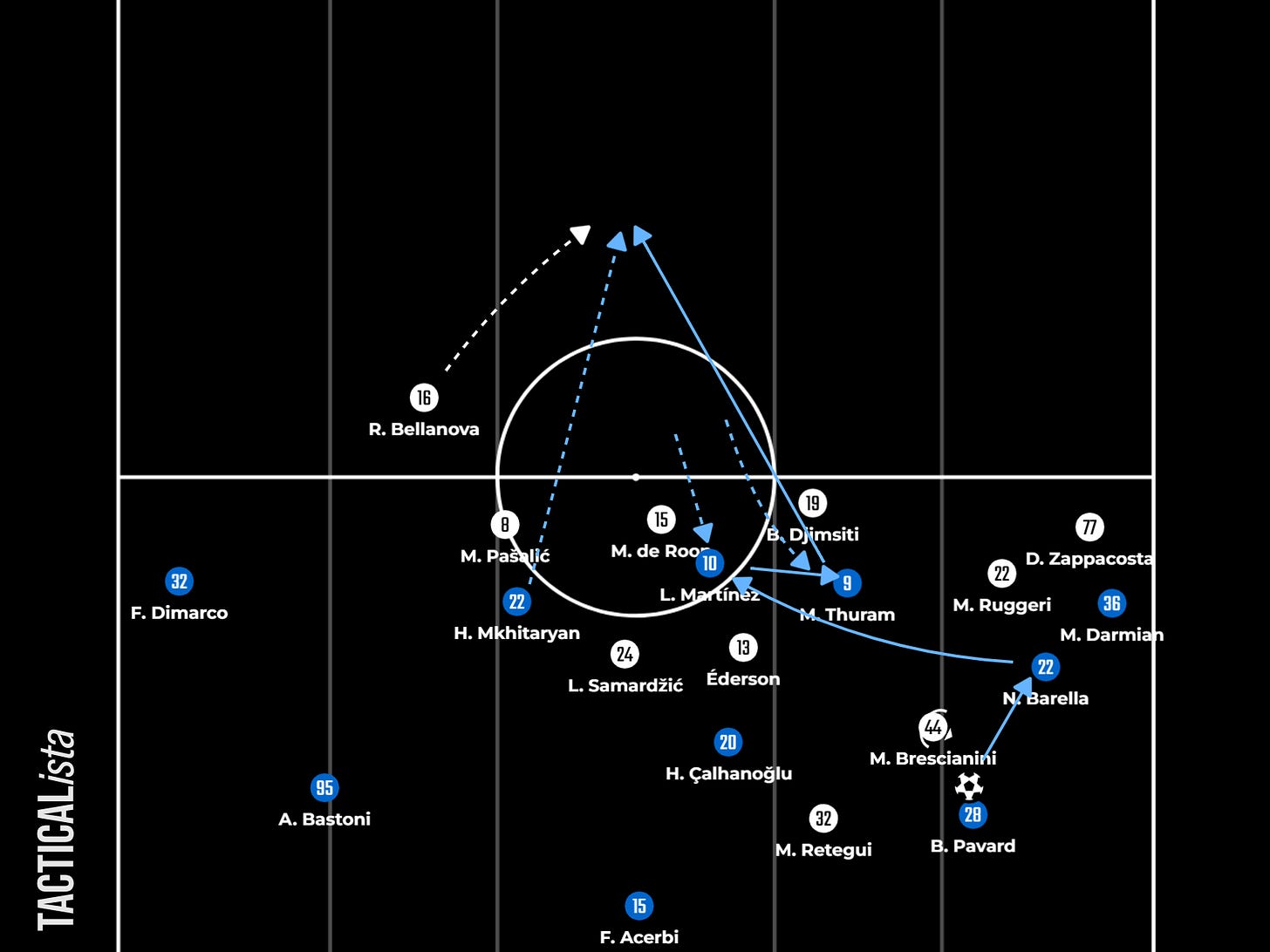
In this example, Inter’s style resembles an archery game: drawing Atalanta’s backline up, relying on Lautaro Martinez and Marcus Thuram's deeper movements (bow) to create space behind and release runners (arrow) from the second line, who is Mkhitaryan in this sequence.
Under Simone Inzaghi, Inter attained a level where they cut through opponents once they were provided with a small space to play. Opponents pressed their main progressors in midfielders. Nonetheless, the strikers emerge between the lines to link to play. They become so drilled in the initial phase, which makes the life of the opponents daunting.
Here, Inter is stuck on the left side as all four of Manchester City’s front players are ready to jump. Haaland prepares to sprint toward the goalkeeper in case Bastoni plays the ball to Sommer. Grealish body language insinuates his readiness to pounce on Pavard and Bernardo Silva keeps his position close to Augusto. Thus, Bastoni cannot opt for sideways options. Behind Manchester City’s first line of the press, Rico Lewis pushes on to press Mkhitaryan, and Rodri deals with Acerbi and Çalhanoğlu.
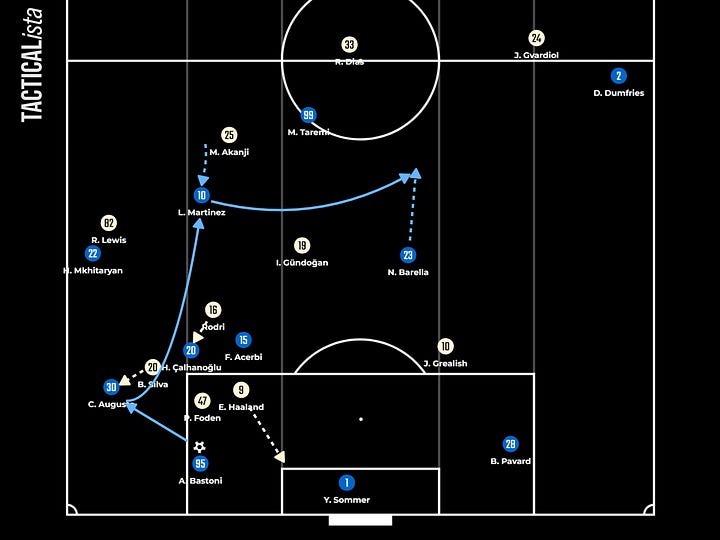

Nevertheless, Inter could progress thanks to Çalhanoğlu’s position. To elaborate, Bernardo Silva keeps close proximity between Augusto and Acerbi to quickly react to Bastoni’s subsequent actions. Phil Foden jumps onto him screening Çalhanoğlu, so Augusto appears to be the only outlet. As a reaction, Bernardo Silva delayed his jump as he aimed to assure Çalhanoğlu was on Rodri’s Radar. That gained Augusto enough space to pick out Lautaro Martinez, dropping deep.
Inter exploited Manchester City’s lateness and hesitation in the press to find the striker between the lines and bypass two lines of the opposition press. Inzaghi’s men generated an artificial transition in which they seemed attacking in three versus three ‘on the break’.
Rotations, and positional interchanges to create
Simone Inzaghi brought into reality a free-flowing playing style based on lightning-fast passing sequences backed up with swift rotations that are puzzling for Inter players at first-hand, let alone the opposition, due to the amount of movement and players that circulate around each player. However, Inter became masters of interpreting spaces to move into in order to soak up pressure on other teammates, create space for runners, or generate chances to score. As a result, resource allocation to mark Inter players emerges as a big burden and problems for opponents.
Here, Benjamin Pavard carries the ball upward, hands the ball to Darmian, and continues his way forward to drag Brescianini with him. That allows Darmian to find space inside and indent feeding Mkhitaryan next to him. Meanwhile, Nicolo Barella traveled from the center as he was acting as a second striker toward the right flank, vacating that area for Darmian to dart into. Darmian’s movement in the box serves his teammate, Marcus Thuram, as he draws De Roon’s attention, leaving the French striker in one-versus-one against Djimsiti.
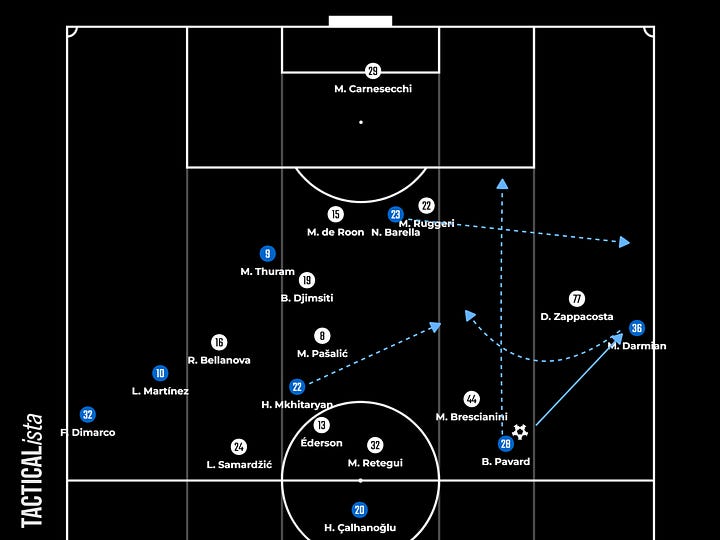

Also, it is worth noting that Lautaro Martinez sneaking behind Djimsiti and attacking the box from his blindside forced Atalanta’s center-back to follow him, creating space for Thuram to receive Çalhanoğlu pass. However, Thuram's ball control wasn’t good, which gave Djimsiti the chance to react quickly.
Notice here how Inter’s attack started and finished. Initially, Darmian operated as a right-wingback, Pavard played as an inside underlapping center-back, and Barella filled the striker zone. At the end of the attack, Darmian and Barella swapped positions, with Pavard maintaining his place in the right-inside channel.
Simone Inzaghi put more emphasis on occupying the five corridors and securing an appropriate players’ distribution all over the pitch, with every cog having enough requirements for his situational role.
For instance, here, Manchester City defends in a zonal fashion, sitting in a 4-4-2 medium block. Inter recycling back lures Manchester City to transform into a man-oriented press.

In detail, Inter midfielders, Zieliński, Çalhanoğlu, and Barella drop in to form a situational backline, with Acerbi making it four. The rest of the team join the last line, in which Yann Bisseck hugs the touchline on the right and Darmian tucks inside. On the left, Augusto moves back toward Acerbi with Bastoni running ahead as a decoy to deceive Bernardo Silva into tracking him in order to evacuate the space for Mehdi Taremi to drop into. That enables Inter to switch the play to the underloaded side, where Bisseck finds Darmian behind to play the cross, but nobody is near the spot to take it.
Inter ran the same plot lines against Juventus in the 48th minute of their 4-4 draw, with one difference: Inter progressed down the same side. In this scene, Zieliński stepped down to the backline, Dimarco came toward Bastoni, and Mkhitaryan shifted across, pulling McKennie along. Zieliński and Mkhitaryan's opposite movements in a vertical direction opened a gap between Juventus lines, as the first dropping to the defense with Bastoni holding the ball drew the Old Lady’s first line of the press and Conceição up top whereas Mkhitaryan’s diagonal move with Inter striker’s pinning the backline pushed Juventus defense backward.


Inter Inzaghi is well drilled to play from first-time touches, which give them the edge to connect passes even if they have opponents sticking to their back or coming from sideways. Here, Mkhitaryan swiftly combined with Dimarco who found Lautaro sneaking deep. Dimarco’s run down the left-inside channel prevented Kalulu from jumping onto Lautaro. That saw him operate in space and pick out Dimarco behind.
Wide combinations are another tool Inter masters to get their wide center-backs or wingbacks in positions to neatly cross the ball toward the box. Inter wide combinations are usually accompanied by rotations to pull opposition wide defenders apart and create space behind their backs.
In their 4-4 draw against Juventus, Inter scored their first goal from a penalty kick won by Marcus Thuram running toward Danilo to receive Pavard’s cross. Before, some tactical events took place. Alessandro Bastoni shifted wide on the left, allowing Piotr Zieliński to drop to the backline. That saw Pavard hug the touchlines behind Denzel Dumfries, who advanced high up the pitch. At the beginning of the attack, Nicolo Barella occupied the right-inside channel.


While circulating the ball, Dumfries dragged Juventus left-back Juan Cabal with him to open up space for Pavard to dash into. In addition, Nicolo Barella drifted wide, receiving the pass and sending the ball into space for Pavard to play it across. At the end of the attack, Barella ended up playing as a wide center-back, Dumfries tucking inside, and Pavard operating high near the byline.
Inter’s quick passing sequences and players’ distribution all over the pitch caught opponents off guard. Inter’ Inzaghi's fluid setup drove the opposition to defend in awkward positions that stretched their lines in both dimensions.


Here, Inter built their attack in a 4+1 shape, in which Nicolo Barella plays as a right-back. McTominay moving toward the ball side opens a passing lane for Çalhanoğlu to flick a line-breaking pass to Lautaro Martinez dropping between the lines. Furthermore, Mkhitaryan position keeps Anguissa restrained in the middle of the park. That saw Lautaro swim in space between Napoli’s defensive and midfield lines to lay the ball to Mkhitaryan. Meanwhile, on the right side, Denzel Dumfries narrows inside to free up the channel for Barella to exploit.
In the box, Dumfries attacks the near post, Thuram heads in the middle of the six-yard box, and Dimarco comes from behind to go toward the back post zone. That pushed Napoli’s backline down to vacate the near-spot, space for Lautaro to come late and meet Barella’s cross.
According to the WhoScored website, Inter Central attacks accumulated a rate of 30% of their overall attacks, with more emphasis on the wide channels. Simone Inzaghi relies on his wingbacks to create chances from crosses and cutbacks. However, they are able to produce opportunities down the central corridor.
Against Juventus, Inter benefited from the numerical superiority they had because they played with three in midfield, with Juventus defending with two players. In addition, Marcus Thuram and Lautaro Martinez pinning Juventus center-backs prevented them from jumping over.
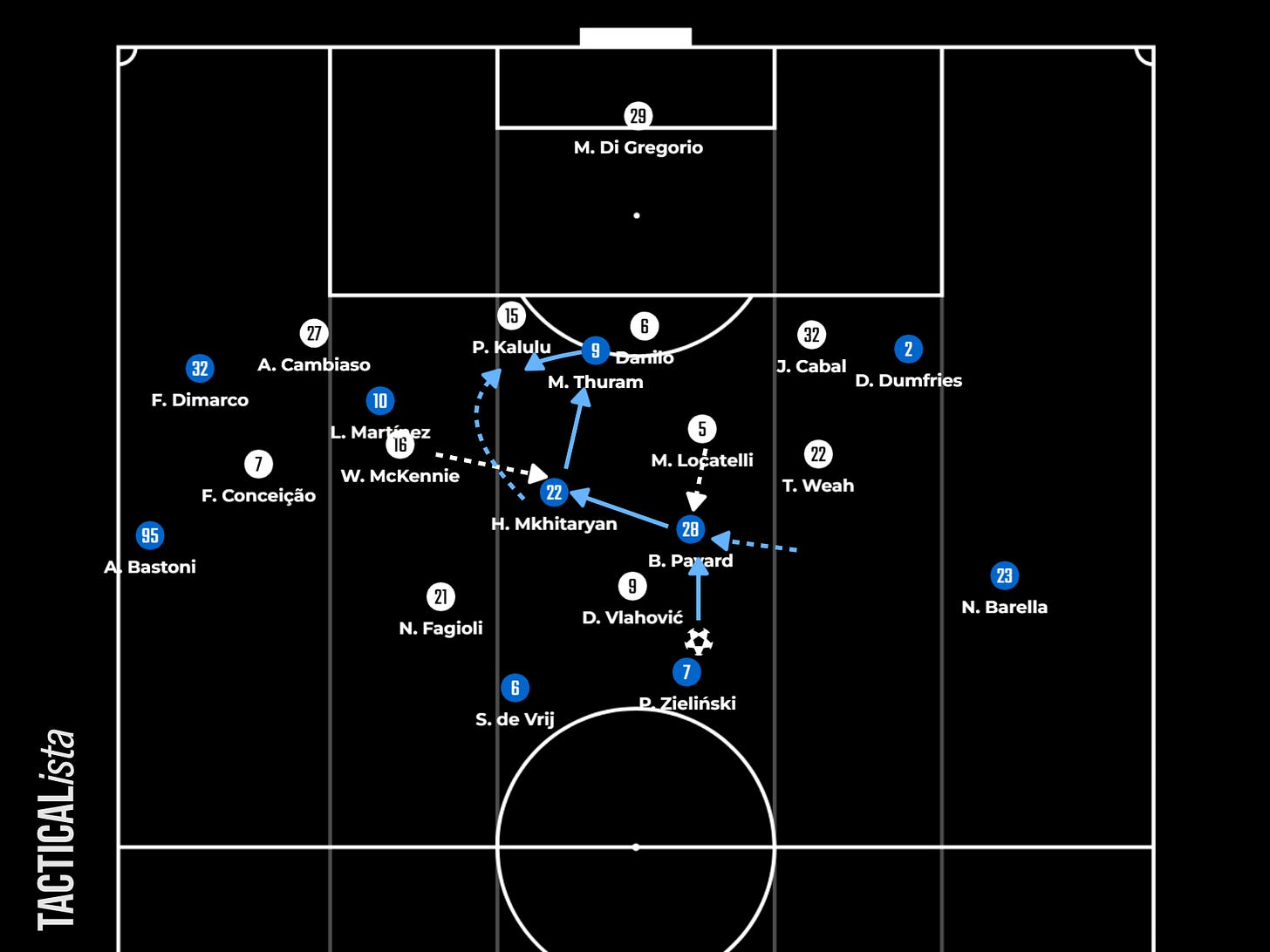
Here, Lautaro Martinez strolls between the lines, drawing McKennie’s attention. Consequently, Locatelli is left overloaded by Pavard who tucks inside, and Mkhitaryan. McKennie’s late shift and Locatelli's delayed jump eased the combination between Zieliński, Pavard, and Mkhitaryan. The latter works a one-two with Thuram to send the ball home.
Even against one of the most aggressive pressing systems, Inter could find an outlet to progress down the thirds, using simplistic movements from the strikers to create space and exploiting opponents’ lateness on the press. Space and time accompanied by off-ball dynamics are Inter’s capital to frustrate rivals.
Arsenal is one of the fewest teams in Europe that masters defending in a low and medium block and pressing high up the pitch. Nonetheless, progressing around appeared to be the key for Inter to arrive at Arsenal’s box.
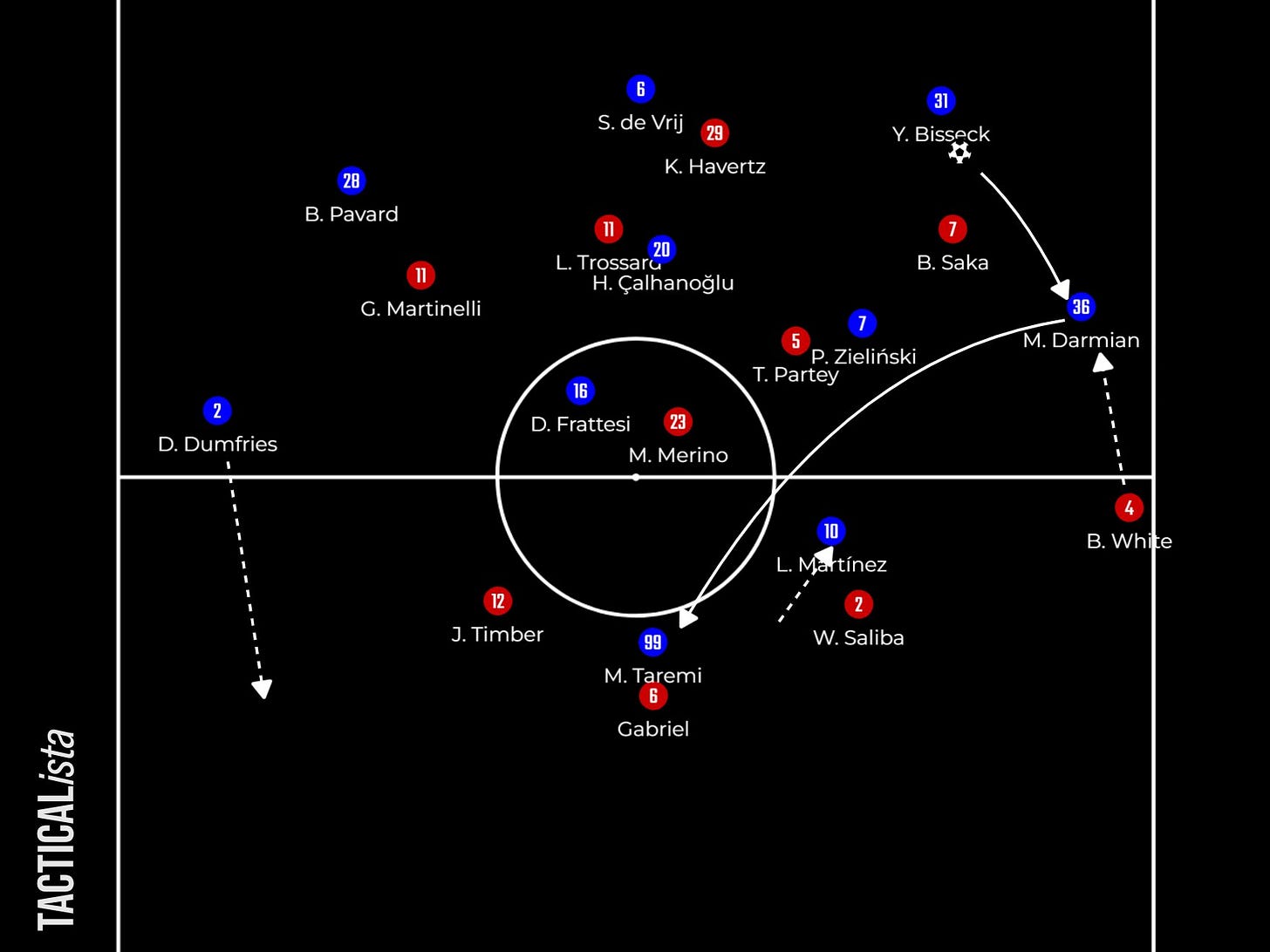
In this example, Bukayo Saka ran toward Yann Bisseck with his body half-oriented toward the touchline as a precaution to prevent Bisseck from picking out Zieliński in midfield. However, Saka’s body orientation left the wide option accessible. Ben White was late to push up onto Darmian. So, William Saliba was caught in two minds about whether to cover behind Ben White or stand still with Lautaro Martinez. The latter made a decoy movement between the lines to let Darmian’s pass and to find Taremi. Mikel Merino shifted toward the ballside, leaving his man Fratessi free to advance, which caught Timber’s attention. As a result, Zieliński spotted Dumfries coming from behind on the right.
Here, Mikel Arteta makes Martinelli take charge of Frattesi with good follow-up patterns when Inter switches the play through short passes. At the beginning of the buildup, Trossard and Saka swapped positions. Trossard and Partey maintained close distance with Zieliński, and Merino appeared to be taking charge of Çalhanoğlu until Lautaro Martinez popped up behind, which take out Merino’s attention. Therefore, Sommer fed Çalhanoğlu, who opted for sideways options instead of exploiting Lautaro’s deeper position (maybe because Martinelli could catch up on him using his pace and close proximity with Lautaro). Inter recycled possession.
Yann Bisseck pushing up the pitch and strikers coming deep were the counter dynamics; Inter looked to execute to bypass Arsenal’s press. The Gunner's follow-ups limited Inter outlets until the moment Torssard didn’t track back Bisseck. In this scene, Yann Sommer targeted the striker with a long pass. Lautaro Martinez came before Gabriel Magalhães and headed the ball down to Taremi behind. In the meantime, Ben White was marking Darmian and Yann Bisseck was attacking the space behind.
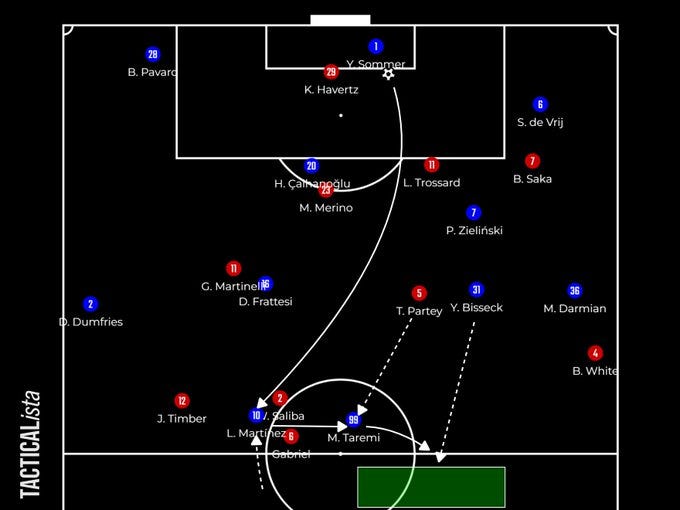
Notice how Inter’s rotations obligated Arsenal’s players to vacate their spots, make inaccurate decisions, and defend in cumbersome and unusual situations, to name a few:
Bisseck was left free to run behind;
Gabriel Magalhães vacated his position to win the ball in the air and left Taremi unmarked behind;
William Saliba followed Lautaro Martinez but couldn’t get the ball in the air.
Takeaways
It seems that Inter’s playing style is neatly working in Serie A and the UEFA Champions League, reaping fruits along the way. A system is built around sophisticated rotations accompanied by quick combinations to progress and hurt opponents. The recent history of Inter is established by Simone Inzaghi who is demonstrating his tactical acumen and wise coaching. A manager whose place is among the greats at the top throughout this period.
If you’re enjoying what we are producing—whether it’s an analysis, scouting, or opinion—Please subscribe, leave a comment, and drop a like. It helps us know that people out there value the work, and it boosts us on the Substack algorithms.
“Sharing knowledge is not about giving people something, or getting something from them. That is only valid for information sharing. Sharing knowledge occurs when people are genuinely interested in helping one another develop new capacities for action; it is about creating learning processes.”~Peter Senge





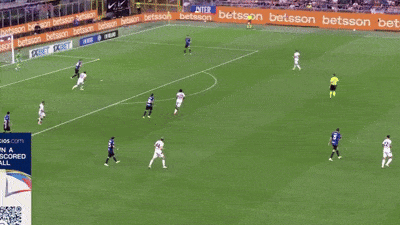


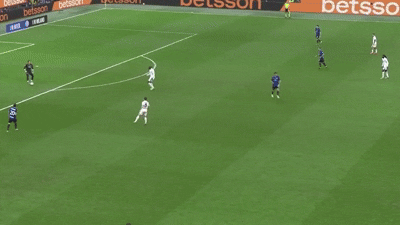
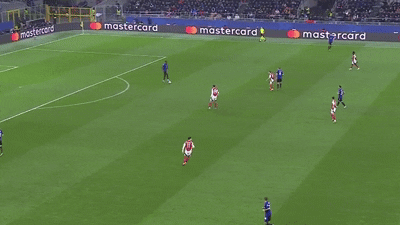
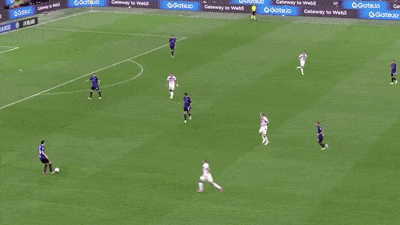


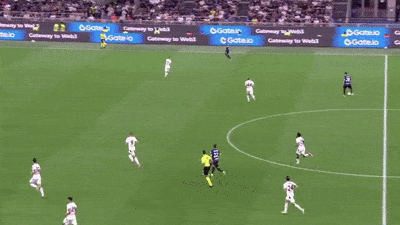

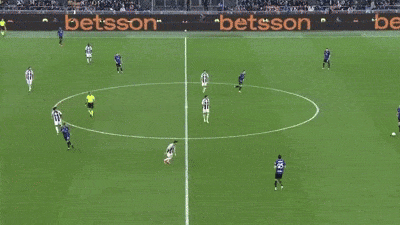


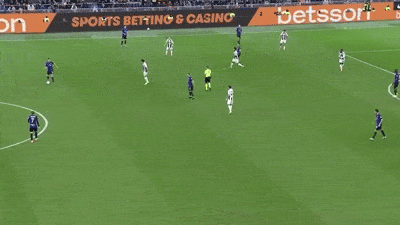
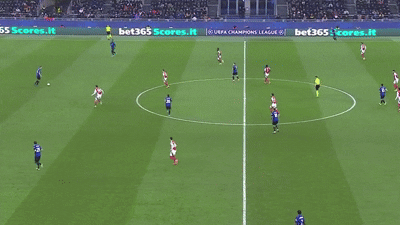
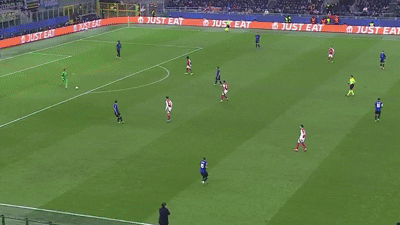
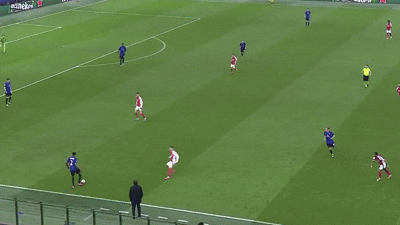
Wonderful work Achraf. You're making football more understandable at the macro and micro scale with each read. Appreciate it
Probably the most in-depth tactical breakdown of a style of play I've seen on here. Top notch stuff! 👏🏼👏🏼